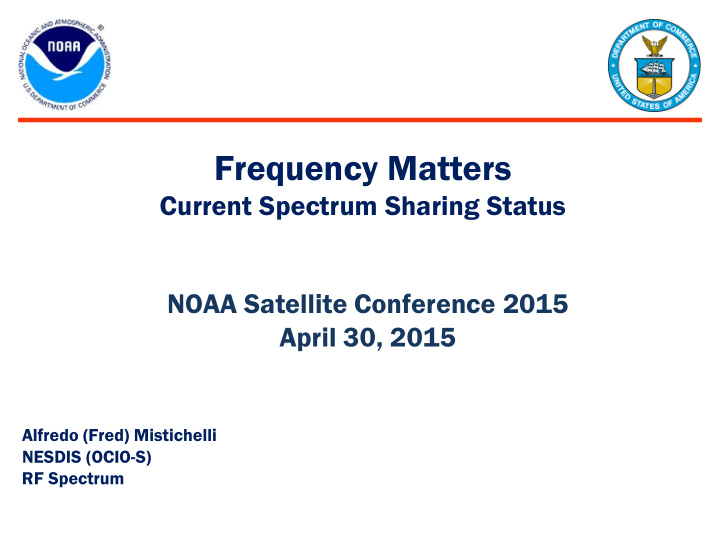



Frequency Matters Current Spectrum Sharing Status NOAA Satellite Conference 2015 April 30, 2015 Alfredo (Fred) Mistichelli NESDIS (OCIO-S) RF Spectrum
Overview • Spectrum Management Defined • Satellite Program Spectrum Requirements • Current Spectrum Sharing Status 2
Spectrum Management Defined Spectrum Management - Planning, coordinating, and managing joint use of the electromagnetic spectrum through operational requirements, engineering analysis, and applicable National and International administrative procedures & regulations. Spectrum Management Objective - To enable electronic systems to perform their mission functions in the intended environment without causing or suffering unacceptable interference. 3
Satellite Program Spectrum Requirements • NESDIS Satellite Program Offices MUST obtain spectrum certification and obtain frequency authorization prior to transmitting. This certification and authorization is obtained by the NESDIS Spectrum Manager and the DOC/NOAA RFMD from the Federal spectrum regulator (National Telecommunication and Information Administration (NTIA)) • Satellite Registration with the International Telecommunication Union (ITU) is required in coordination with the NTIA spectrum certification process and interface with DOC/NOAA RFMD • NESDIS Spectrum Management has Program Lifecycle requirements from conception to decommissioning (i.e. NTIA 5 Year Validations, Engineering Change Proposals (ECPs), Radio Frequency Interference (RFI) mitigation, etc.) 4
Spectrum Sharing 1695-1710 MHz Auction Middle Class Tax Relief and Job Creation Act of 2012 (PUBLIC • LAW 112–96–FEB. 22, 2012) 1695-1710 MHz auction complete (part of AWS-3) • Major NOAA efforts to enable 1695-1710 MHz sharing: • GOES-R frequencies shifted below 1695 MHz Development, management and operation of a Spectrum Coordination Portal to address requests for commercial operations within Protection Zones Development, deployment, and operation of a Spectrum Monitoring System to monitor for potential harmful interference Replacement of the current Radiosonde Observing Systems (relocate to a lower frequency band) NOAA ground stations protected by Protection Zones • NOAA and non-federal direct broadcast receivers outside • Protection Zones may receive interference 5
1695-1710 MHz Band Sharing Estimated Costs and Timelines 6
Potential Impacts if 1675-1695 MHz is Shared with Mobile Broadband Interference could degrade severe weather monitoring and • prediction from satellites (e.g. hurricane tracking, floods,) Users of Emergency Managers Weather Information Network • (EMWIN), 1692.7 MHz, broadcasts outside protection zones will be subject to interference. Could prevent reception of data needed to make critical decisions with weather forecasts, warnings, alerts and other safety of life and property information during emergency situations Other communications means cannot provide required availability and reliability Users of DCPR broadcasts, 1692.7 MHz (GOES N-P), 1679.7 MHz • (GOES-R) outside protection zones will be subject to interference. Could prevent reception of hydrological data from sensors deployed nationwide which provide data needed for flood prediction and warnings Could prevent sensor data required for wildfire management 7
Potential Impacts if 1675-1695 MHz is Shared with Mobile Broadband (Cont.) Possible reduction of quality in the regional and global data sets • required for climate monitoring and prediction Band is part of globally coordinated meteorological operations • Sharing could have a negative impact on global harmonization and interoperability 8
NOAA’s Use of 1675-1695 MHz GOES- N/O/P LightSquared AWS-3 GOES- R/S/T/U Future GOES LightSquared AWS-3 9
Summary • NESDIS spectrum management program functional capabilities: – National Spectrum Certification/Authorization Package Development – International ITU Satellite Registrations – RFI Resolution and Lifecycle Spectrum Updates – Engagement in National and International Band Re-allocation, Sharing, and Regulatory Changes 10
Recommend
More recommend